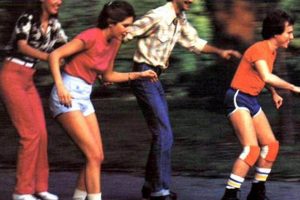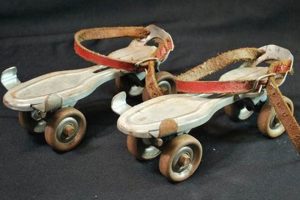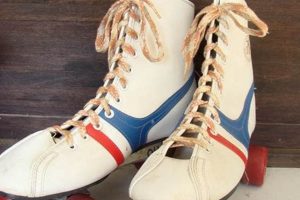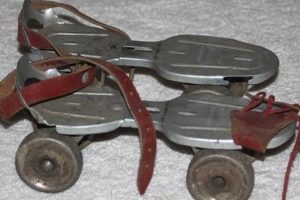Specialized hosiery designed for use with wheeled boots are essential components for comfortable and efficient skating. These coverings, often extending above the ankle, provide a barrier between the foot and the rigid interior of the boot. For example, a thicker variety constructed from moisture-wicking materials can significantly improve the skating experience.
The correct foot covering is paramount for performance and hygiene. It aids in absorbing perspiration, preventing the buildup of moisture that can lead to discomfort and bacterial growth. Historically, simpler versions served primarily as protective layers, but contemporary designs incorporate advanced fibers and ergonomic construction to enhance fit, support, and breathability. This, in turn, can improve control and reduce the likelihood of blisters or chafing during extended use.
The selection of appropriate foot attire is crucial for ensuring optimal performance and comfort. Factors to consider include material composition, thickness, height, and intended use. Subsequent sections will delve into the diverse types available, their respective advantages, and key features to look for when making a purchase.
Essential Considerations for Roller Skating Footwear
Selecting appropriate foot coverings for roller skating is crucial for comfort, performance, and foot health. The following recommendations provide guidance on choosing and utilizing footwear to optimize the skating experience.
Tip 1: Prioritize Moisture-Wicking Materials: Fabrics such as merino wool, synthetic blends, or Coolmax are effective in drawing moisture away from the skin, reducing the risk of blisters and fungal infections. Avoid cotton, which retains moisture and can lead to discomfort.
Tip 2: Choose the Correct Thickness: The thickness should correspond to the fit of the skate. If the skate is already snug, opt for a thinner material. Conversely, if there is excess room, a thicker option can improve fit and provide additional cushioning.
Tip 3: Ensure Adequate Height: The top of the footwear should extend beyond the cuff of the roller skate to prevent chafing and irritation. Over-the-calf styles are generally recommended for most types of roller skates.
Tip 4: Maintain Proper Hygiene: Regular washing after each use is essential to remove sweat and bacteria. Turn the footwear inside out for thorough cleaning and ensure it is completely dry before storing or wearing.
Tip 5: Consider Compression Features: Some models offer compression properties, which can improve circulation and reduce muscle fatigue during extended skating sessions. Evaluate whether this feature aligns with individual needs and preferences.
Tip 6: Inspect for Wear and Tear: Regularly check for holes, thinning, or loss of elasticity. Worn footwear can compromise comfort and increase the risk of blisters. Replace them as needed to maintain optimal performance and foot health.
By adhering to these considerations, individuals can enhance the comfort, performance, and longevity of their roller skating experience. Selecting and maintaining appropriate footwear is a fundamental aspect of responsible roller skating practice.
Further exploration into specific models and brands will provide a more nuanced understanding of the options available and assist in making informed purchasing decisions.
1. Material Composition
The material composition of roller skate hosiery directly affects performance, comfort, and hygiene. The choice of fiber impacts moisture management, friction, and overall durability. For instance, a blend incorporating merino wool offers superior moisture-wicking and odor control compared to cotton, which tends to retain perspiration. Similarly, synthetic materials like nylon or polyester can enhance durability and provide a smoother surface to reduce friction within the skate boot.
Consider a skater using basic cotton socks. Rapid moisture buildup could lead to blistering and discomfort, detracting from their performance and potentially leading to skin irritation. In contrast, a skater utilizing a synthetic blend with targeted ventilation zones experiences enhanced airflow and reduced moisture, resulting in a more comfortable and controlled skating session. The selection of appropriate materials, therefore, functions as a crucial element in optimizing the roller skating experience. It directly influences foot health and skating efficiency.
Ultimately, understanding the relationship between material composition and the functionality of roller skating foot coverings is essential for making informed purchasing decisions. Selecting materials that prioritize moisture management, durability, and reduced friction contributes significantly to improved performance and enhanced foot health. Challenges in material selection often lie in balancing cost-effectiveness with performance requirements; however, prioritizing quality materials ultimately leads to a more positive and sustainable skating experience.
2. Thickness Variability
The thickness of hosiery utilized in conjunction with roller skates plays a pivotal role in both comfort and performance. Variations in thickness influence the fit of the skate, the degree of cushioning provided, and the transmission of force during maneuvers. A hosiery option that is excessively thin may fail to provide adequate protection against friction, leading to blisters and discomfort. Conversely, an overly thick option can compromise the fit of the skate, potentially restricting blood flow or hindering ankle mobility. The selection of an appropriate thickness, therefore, is not merely a matter of personal preference but a critical factor affecting the skater’s overall experience. For example, competitive skaters often favor thinner, performance-oriented options to maximize responsiveness, while recreational skaters may opt for thicker, more cushioned varieties to enhance comfort during longer sessions.
The correlation between hosiery thickness and skate fit can be understood through a simple analogy. Imagine attempting to wear shoes that are already snug with exceptionally thick hosiery; the resulting pressure points and restricted movement are analogous to the effects of using inappropriately thick hosiery in roller skates. Conversely, wearing excessively thin hosiery in skates that are slightly too large can exacerbate slippage and reduce control. Manufacturers often provide guidance on the recommended hosiery thickness for specific skate models, taking into account the internal dimensions and intended use. Ignoring this guidance can lead to suboptimal performance and an increased risk of injury. Furthermore, the environmental conditions in which skating occurs also influence the ideal thickness. Cold weather skating may warrant thicker options for increased insulation, while hot weather skating may necessitate thinner, more breathable varieties to minimize perspiration buildup.
In summary, the variability in hosiery thickness is a crucial consideration in the context of roller skating. The appropriate thickness must be carefully selected to optimize skate fit, maximize comfort, and enhance performance. Failure to account for this factor can result in discomfort, reduced control, and an increased risk of injury. Future investigations might explore the development of hosiery with variable thickness zones, providing targeted cushioning and support in areas of high stress while maintaining a streamlined fit in other areas. Understanding and properly addressing the complexities of hosiery thickness is thus essential for both skaters and manufacturers seeking to improve the overall skating experience.
3. Height Consideration
The height of roller skate hosiery is a significant factor affecting comfort and protection. Insufficient height leads to direct contact between the skate’s cuff and the skin, resulting in friction, chafing, and potential blistering. Conversely, excessive height, while seemingly innocuous, can impact mobility if the hosiery material bunches or restricts joint movement. The correct height ensures a protective barrier without hindering the skater’s range of motion. For example, if the hosiery terminates below the top edge of the skate boot, repetitive movements inevitably cause irritation and discomfort around the ankle area. Therefore, the primary objective is to select hosiery that extends beyond the skate cuff, creating a smooth interface and minimizing skin abrasion.
Practical application of height consideration involves assessing the specific dimensions of the roller skate in question. Different skate models possess varying cuff heights, necessitating adjustments in hosiery selection. Racing skates, often characterized by lower-cut designs, may require shorter hosiery compared to recreational or artistic skates, which typically feature taller cuffs for increased ankle support. Furthermore, individuals wearing supportive ankle braces beneath their skates must account for the added bulk and choose hosiery with sufficient length to accommodate both the brace and the skate cuff. Ignoring these factors may result in discomfort or compromise the effectiveness of the brace itself. Specificity in hosiery height selection is essential for customized comfort and performance.
In conclusion, the height of roller skate hosiery represents a critical element in ensuring comfortable and safe skating experiences. Addressing this aspect involves careful consideration of skate design, individual anatomical needs, and specific performance demands. While seemingly minor, a failure to adequately address hosiery height can result in significant discomfort and detract from the overall skating experience. Understanding this relationship remains crucial for both casual and competitive skaters, emphasizing the importance of selecting hosiery tailored to individual requirements and skate characteristics. Further research exploring optimal hosiery heights for various skate styles could provide additional insights and benefits to skating communities.
4. Moisture control
The effectiveness of roller skate hosiery is intrinsically linked to its capacity for moisture control. Within the confined space of a roller skate, the foot generates perspiration, creating a humid environment conducive to bacterial growth and blister formation. Hosiery with poor moisture control exacerbates these conditions, leading to discomfort, compromised hygiene, and reduced performance. Conversely, hosiery engineered for effective moisture management mitigates these risks, promoting a drier, more comfortable, and healthier skating experience. For instance, during extended skating sessions, hosiery made from moisture-wicking materials actively transports perspiration away from the skin, preventing its accumulation and subsequent irritation. This directly impacts the skater’s ability to maintain focus and control, particularly during demanding maneuvers.
Practical applications of moisture control technology in roller skate hosiery are evident in the diverse material selections available. Synthetic fibers, such as polyester and nylon, are often employed for their hydrophobic properties, actively repelling moisture rather than absorbing it. Merino wool, a natural fiber, offers a unique combination of moisture absorption and breathability, effectively regulating temperature and minimizing the risk of overheating. Furthermore, specific weaving patterns and ventilation zones can be incorporated into the hosiery’s design to enhance airflow and facilitate moisture evaporation. The choice of material and construction directly impacts the skater’s comfort and performance, particularly during prolonged or intense skating activities. Improper moisture management can manifest as slippage within the skate, increasing the risk of falls or injuries. Moreover, persistent moisture can degrade the structural integrity of the skate’s inner lining, reducing its lifespan and necessitating premature replacement.
In summary, moisture control represents a critical determinant of roller skate hosiery performance and contributes significantly to the overall skating experience. Effective moisture management minimizes the risk of discomfort, bacterial growth, and blister formation, while simultaneously enhancing control and hygiene. Challenges in achieving optimal moisture control lie in balancing material breathability with durability and cost-effectiveness. Continued innovation in material science and hosiery design will likely yield further improvements in moisture management capabilities, ultimately benefiting both recreational and competitive skaters. Prioritizing hosiery with proven moisture-wicking properties constitutes a sound investment in comfort, performance, and foot health.
5. Friction Reduction
Friction reduction is a primary function of roller skate hosiery, influencing comfort, performance, and the longevity of both the skater’s feet and equipment. Hosiery acts as a critical interface between the foot and the interior of the skate, mitigating the abrasive forces generated during repetitive movements.
- Material Selection and Surface Properties
The choice of material significantly impacts friction. Smooth, low-friction fabrics such as synthetic microfibers or treated natural fibers minimize rubbing against the skin and the skate lining. The surface texture also plays a role; seamless construction and flat-knit designs reduce points of concentrated friction. For example, hosiery incorporating polytetrafluoroethylene (PTFE) fibers further decreases friction, promoting smoother movement and reducing the likelihood of blisters.
- Moisture Management and Boundary Lubrication
Moisture exacerbates friction. Hosiery with effective moisture-wicking properties keeps the foot dry, preventing the skin from becoming soft and more susceptible to abrasion. Dry skin experiences less friction than hydrated skin. Furthermore, some materials, when combined with perspiration, create a boundary lubrication effect, reducing the coefficient of friction between the foot and the skate. This phenomenon is observed with certain synthetic blends and treated wool.
- Fit and Conformity to Foot Contours
Proper fit is essential for minimizing friction. Hosiery that is too loose bunches and creates folds, leading to increased rubbing and hot spots. Conversely, hosiery that is too tight restricts blood flow and can create pressure points. Hosiery with anatomical designs and elastic properties conforms closely to the contours of the foot, eliminating gaps and minimizing movement within the skate. This reduces the shearing forces that contribute to friction-related injuries.
- Construction and Seam Placement
The construction of the hosiery directly impacts friction levels. Seamless designs eliminate abrasive seams that can rub against the skin, particularly in areas prone to friction such as the toes, heel, and ankle. When seams are necessary, flat-lock stitching minimizes bulk and prevents irritation. Reinforcements in high-wear areas, such as the heel and toe, enhance durability and prevent the hosiery from thinning, which would otherwise increase friction.
These facets illustrate how careful consideration of material selection, moisture management, fit, and construction details contribute to friction reduction within the roller skate environment. By minimizing friction, roller skate hosiery enhances comfort, improves performance, and reduces the risk of blisters, calluses, and other foot injuries, ultimately extending the life of the skater’s feet and equipment.
6. Fit specificity
The fit specificity of roller skate hosiery represents a crucial determinant of comfort, performance, and foot health. Precise fit minimizes friction, prevents bunching, and ensures effective moisture management. Hosiery that is either too loose or too tight compromises these functionalities. Incorrect sizing leads to discomfort, blistering, and potentially impaired circulation, hindering the skater’s ability to perform optimally. A real-world example is evident in skaters experiencing “hot spots” due to hosiery folds or constricted toes due to excessively tight materials. These issues underscore the importance of selecting roller skate hosiery that conforms closely to the individual’s foot shape and size.
Practical applications of fit specificity principles manifest in the diverse sizing options and anatomical designs available in the market. Manufacturers provide size charts correlated to standard shoe sizes, aiding in the selection of appropriately sized hosiery. Further refinement is achieved through anatomical designs incorporating features such as contoured heel pockets and reinforced toe boxes. These features enhance the fit and minimize slippage within the skate, contributing to increased comfort and control. The consideration of arch support and compression zones further enhances fit and supports foot stability during skating. For instance, skaters engaged in aggressive skating disciplines may benefit from hosiery featuring compression to improve circulation and reduce muscle fatigue.
In summary, fit specificity is an indispensable attribute of roller skate hosiery. Achieving optimal fit requires careful consideration of sizing, anatomical design, and material properties. While challenges exist in accommodating diverse foot shapes and sizes, the benefits of precise fit specificity are undeniable. Prioritizing fit specificity leads to enhanced comfort, improved performance, and a reduced risk of foot-related injuries. Continued innovation in hosiery design and sizing systems promises further advancements in achieving personalized fit and maximizing the benefits for all roller skating participants.
7. Durability expectations
The lifespan of roller skate hosiery is a direct function of material composition, construction techniques, and usage intensity. Expectations regarding longevity must align with these factors to ensure cost-effectiveness and consistent performance. For instance, hosiery constructed from a blend of synthetic fibers designed for high abrasion resistance exhibits a longer service life than hosiery made from less robust natural fibers, given comparable usage. Consequently, purchasers should consider the anticipated frequency and rigor of skating activities when evaluating durability claims. Routine recreational skating necessitates a different level of resilience than competitive or aggressive skating, where the hosiery is subjected to greater stress and wear.
The significance of durability expectations stems from the direct impact on both economic considerations and performance maintenance. Premature failure of roller skate hosiery necessitates frequent replacement, increasing overall expenditure. Furthermore, worn or damaged hosiery compromises comfort and protection, potentially leading to blisters, abrasions, and reduced control. Real-world examples include skaters experiencing accelerated wear in the heel or toe areas due to friction against the skate boot. This can be mitigated by selecting hosiery reinforced in these high-stress zones. Understanding the correlation between material properties, construction, and durability allows consumers to make informed purchasing decisions, optimizing the balance between cost and performance.
In conclusion, durability expectations are a critical component in the selection and utilization of roller skate hosiery. Aligning these expectations with the anticipated usage and material properties is essential for maximizing the value and performance of the product. Addressing the challenge of balancing cost with longevity requires a thorough understanding of the factors contributing to hosiery wear and tear. This understanding empowers consumers to prioritize durability as a key criterion, ensuring a more comfortable, cost-effective, and sustainable skating experience.
Frequently Asked Questions About Roller Skate Socks
The following addresses common inquiries related to the selection, use, and maintenance of specialized hosiery designed for roller skating activities.
Question 1: What distinguishes dedicated roller skate hosiery from standard athletic hosiery?
Roller skate hosiery is engineered with specific performance characteristics, including enhanced moisture-wicking capabilities, strategically placed cushioning, and reinforced construction to withstand the rigors of skating. Standard athletic hosiery may lack these tailored features.
Question 2: How does the material composition of roller skate hosiery impact performance?
The material directly influences moisture management, friction reduction, and overall durability. Synthetic blends offer superior moisture-wicking properties compared to natural fibers like cotton, which tend to retain perspiration and contribute to discomfort.
Question 3: What is the recommended frequency for laundering roller skate hosiery?
Roller skate hosiery should be laundered after each use to remove accumulated perspiration and prevent the growth of bacteria. Failure to maintain proper hygiene can lead to unpleasant odors and an increased risk of skin infections.
Question 4: How does hosiery thickness impact the fit of roller skates?
Thickness affects the overall fit and feel of the skate. Excessively thick hosiery can create pressure points and restrict circulation, while hosiery that is too thin may offer inadequate cushioning and protection. Choosing a thickness that complements the skate’s internal dimensions is crucial.
Question 5: What features should one prioritize when selecting roller skate hosiery for competitive skating?
Competitive skaters should prioritize hosiery that offers minimal bulk, maximum breathability, and enhanced moisture management. Compression features can also improve circulation and reduce muscle fatigue during demanding performances.
Question 6: Can standard socks be used as a substitute for roller skate hosiery?
While standard hosiery can be used temporarily, dedicated roller skate hosiery provides superior performance and protection. Standard options often lack the specialized features necessary to withstand the demands of skating, potentially leading to discomfort or injury.
Proper selection and maintenance of roller skate hosiery are essential for optimizing comfort, performance, and foot health during skating activities. Adherence to these guidelines contributes to a more enjoyable and injury-free skating experience.
Further investigation into specific brands and models can provide more detailed insights into the available options and assist in making informed purchasing decisions.
Conclusion
The preceding analysis has explored the multifaceted role of specialized foot coverings within the context of roller skating. Factors ranging from material composition and thickness to height, moisture control, fit, and durability have been examined. Each aspect contributes significantly to the overall comfort, performance, and safety of the skater. Neglecting these considerations can lead to compromised experiences and potential injury.
Therefore, the selection and maintenance of appropriate hosiery are not trivial matters. Thoughtful attention to the characteristics outlined provides a pathway to enhanced performance, improved foot health, and a more sustainable engagement with the activity. Continued research and development in this area remain vital to optimize the interface between skater, equipment, and performance.







